|
Left the hotel "Okinawa Kariyushi Urban Resort" in Naha City
at 8:00 a.m.
Fine weather is probably going to bless us whole day today. The temperature
is already over 20℃. All of us are in light clothes.
After the bus ride of nearly 1 hour, we had a shopping time at Naha Shopping
Center and the Galleria, a duty-free store for 2 hours totally.
Until 3 o'clock from then we, 2 couples, had an optional tour around the
Southern Area. All others went to stroll on the Naha International Street
in their way.
Thankful to say, we were attended by the driver, the guide and the attendant
all the way.
As for our couple, we had once visited Shuri Castle, mentioned in the last chapter, Lily Tower, Peace Memorial Park and Ryukyu Village 12 years ago in 2002. The pictures are no doubt an evidence themselves, but I have no memory of impression.
This trip made me recall most of the memorial monuments, buildings and
landscapes then. In addition, the today's sightseeing was much more than
a pleasure trip to me.
Lily Tower
This spot was not included in the original plan, however, the strong request
of another couple was accepted and realized on the way to Peace Memorial
Park.
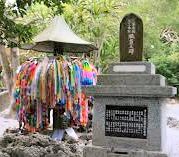 This memorial called Lily Tower is at the remains of the Okinawa Army Hospital.
It was unveiled in 1946, the next year the war ended. "Lily Tower"
was named after the Lily Girl Student Team. This memorial called Lily Tower is at the remains of the Okinawa Army Hospital.
It was unveiled in 1946, the next year the war ended. "Lily Tower"
was named after the Lily Girl Student Team.
All girls in the team made their efforts in the moat, not knowing the end
of the war.
It is called a tower, but its height is actually several tens cm, because
it was built when lack of materials just after the war and under the rule
of the United States Army.
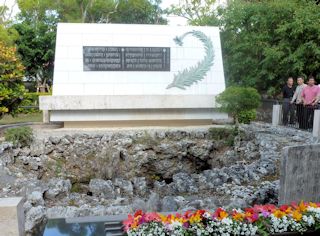
Peace Memorial Park
This memorial park in Itoman City is located on the plateau facing Mabuni
Hill, the place of the end of Okinawa Battle, and viewing the coast line
on the southern east.
In the Peace Memorial Park, wartime photographs and objects are displayed
at the Peace Memorial Museum, and the names of those who perished during
the Battle of Okinawa are inscribed on the "Cornerstone of Peace"
monument.
The Peace Prayer Memorial Statue that prays for the souls of those killed
in wars and for everlasting world peace can also be found on the site,
and the National War Dead Peace Mausoleum, along with 50 monuments from
other prefectures and organizations are all located on Mabuni Hill in the
southern region of the park. (Okinawa Prefecture Peace Memorial Foundation) |
|
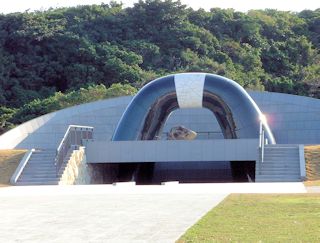 |
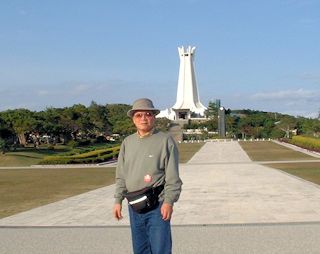 |
The decisive battle at Okinawa, the end of Pacific War in fact, started
in April and continued until late June, 1945.
During the period, total war victims were about 190 thousand including
150 thousand of Okinawan soldiers and residents, 25% of the population
of then Okinawa.
Incidentally, my father was serving himself as a coal miner in Kyushu Region,
not as a soldier, because of his critical illness in the result of his
diving life for pearl oysters around Arafura Sea in his young days.
I also faintly remember my mother joined in the female volunteers exercising
a bamboo spear. It was 1945 when I was five years old.
Nearly 70 years have passed since the war risking Japan's existence ended,
and we are now in 21st century.
I was born one year before the outbreak of Pacific War and lived on the
background of the defeat of Japan.
In that situation, I have no memory that I learnt the history of Showa
period in high school. Concerning the world history the teacher gave up
teaching and spent the time talking comics.
I selected geography and Japanese history as a social science for the entrance
examination to university. The questions of Japanese history at any university
examination were ranged until Meiji period, not after the Russo-Japanese
War.
Despite my idleness, I feel guilty that I overlooked, as no concern of
ours, the situation of Okinawa including Okinawa Battle and the problem
of the U.S. military bases still dragging on, not to mention its history
since Ryukyu Kingdom.
In addition to the ordinary sightseeing, such feeling gave me another influence
during the today's trip of Shuri Castle, Lily Tower, Peace Memorial Park
and various landscapes.
The guide and the attendant were so helpful to me. They were not aggressive but informative.
Gyokusendo Cave
It is in Nanjo City.
Its whole picture of the cave, formed approximately 300,000 years ago,
was revealed for the first time in 1967, when the academic adventure team
of Ehime University had an investigation around there.
It was opened in 1972 by Nanto Company for the purpose of tourism, and
now is one of the sightseeing spots named "Okinawa World Culture Kingdom".
We entered and walked through 890 meters of the cave, opened for sightseeing,
out of 5,000 meters in total.
This cave was a surprise to me because it was something not remarkable
on the way. I was overwhelmed with its scale and each scene.
I remember two caves visited in recent years. Postojna Cave in Slovenia and Akiyoshido Cave in Yamaguchi Pref. The Windcave National Park in the US, visited nearly a half century ago, is not in my memory.
Postojna is probably one of the greatest caves in the world both in scale
and scenery. But I thought this Gyokusendo might be more than Akiyoshido,
and had an extra impression that it should be more advertised.
The following picture is at the exit of the cave.

Wandering off the subject, .....
I got interested in the ties at the souvenir shop of the Culture Kingdom.
They were Wu-ji dyeing. According to the guide lady Nakama,
 "I am sure all of you noticed sugar cane fields from the bus window.
We call a sugar cane as wu-ji. The leaves and ears of wu-ji are boiled
and become a dye. They change collors to green and yellow, which must make
you feel at ease." "I am sure all of you noticed sugar cane fields from the bus window.
We call a sugar cane as wu-ji. The leaves and ears of wu-ji are boiled
and become a dye. They change collors to green and yellow, which must make
you feel at ease."
I just looked around, not buying any tie as I am already unrelated.
But speaking of sugar canes, the material of muscovado, their fields were
refreshing, widened before and after the Culture Kingdom.
There were several other facilities around in addition to Gyokusendo Cave in the Okinawa World Culture Kingdom. One of them was Tropical Orchard, through which we arrived at the Traditional Performing Art Square and enjoyed Eisa, Ryukyu Dance, to the fullest.
All audiences were overwhelmed so much by the drums and sanshin played
dynamically that the applause showed no sign of abating even far after
the dance finished. Emiko and I surely stayed there long, feeling like
dreaming.
(Sanshin is an Okinawan traditional three-stringed instrument.)
--------
We joined in the group near the International Avenue at 3:00 p.m. as planned.
Then all of us went to see Ryukyu Village.
Ryukyu Village
Our couple had visited here in Onnason Village, 12 years ago. It contains
old streets and houses, reproduced by removing and reconstructing old houses
from various places in Okinawa.
I remembered some of the houses and the sound of drums and sanshin.
We were satisfied with seeing the performance of the Okinawan parade and
eisa, and joining the dance.
Is it an appropriate name, a sugar manufacturing factory?
A couple with a water buffalo were working "Sa-ta-ya-" or sugar-manufacturing
by squeezing sugar canes.
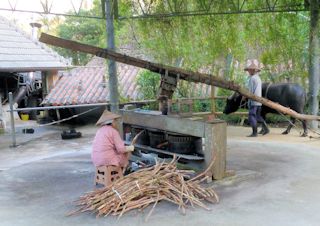
|